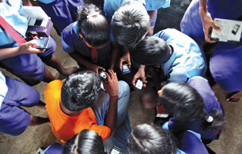 Children at Citta middle School in Orissa, India, use cell phones to access mPowering's incentive and rewards program. (Photo by Gabriel Gastelum, Courtesy of mPowering)
Children at Citta middle School in Orissa, India, use cell phones to access mPowering's incentive and rewards program. (Photo by Gabriel Gastelum, Courtesy of mPowering)
In a rural village in Orissa, the poorest state in India, children often wake up in mud huts with hunger gnawing at their bellies. Until recently, they faced only two choices: Go to school and improve their long-term prospects through education, or skip school and work for a pittance so they can buy a little food. A new organization called mPowering is using technology to deliver a third option: Go to school and earn credits that can be redeemed for food, medicine, and other incentives.
The mPowering model leverages rewards to improve the lives of “the poorest of the poor,” says Kamael Ann Sugrim, co-founder and president of mPowering. “The ultra poor spend 80 percent of their income on food but still fail to meet their daily nutritional needs,” she explains. “That leads to people making short-term decisions because they’re hungry. We want to help them make long-term decisions that will lead them out of poverty.”
Thanks to mPowering, now there’s an app for that. The organization doesn’t provide direct services. Instead, mPowering connects with nonprofit partners such as Citta, which provides education, health care, and other services in high-poverty areas. When Sugrim visits project sites like Orissa or Bhaktapur, Nepal, she finds high concentrations of extreme poverty—as well as cell phone coverage that rivals what she has back home in Silicon Valley.
Through its partners, mPowering distributes smartphones loaded with mobile apps to monitor desired behaviors, such as kids attending school or expectant mothers accessing prenatal care. Participants can cash in their earned credits for “food, medicine, books, or even extras they’d never be able to afford, like bicycles,” Sugrim says.
To implement the program, mPowering has created new job opportunities for adults who serve as local project liaisons. “They tend to be young leaders who want to help their community,” she explains. They’re also handy with mobile devices, which they use to record attendance or take photos to document positive moments.
With another mPowering app, data collected at the project sites is channeled back to donors in real time. For instance, a donor might get a Facebook photo showing a sponsored child celebrating perfect school attendance or eating a nutritious lunch. These real-time updates will help keep donors engaged, Sugrim predicts, “especially the 17-year-olds who are on Facebook and Twitter but also are looking for ways they can make a difference. We think this can unlock this interesting group of young donors and hold their attention.”
Sugrim says the idea for mPowering began to take shape after she spent five years in the corporate world, most recently at Salesforce.com. Co-founder Jeff Martin spent a decade at Apple Computer before starting Tribal Brands, which combines entertainment marketing with mobile technology. Their shared goal is to take advantage of ubiquitous technology, “and reach the bottom bottom of the pyramid,” Sugrim says.
One of their first challenges was to develop picture-based mobile applications to get around literacy and translation issues. The picture-based apps run on smartphones, not the simpler cell phones that are more common in the developing world.
MobileActive, which focuses on mobile technologies for social change, has documented the use of phones to promote health care, microfinance, literacy, and other efforts. “Fairly simple apps are accomplishing a lot of interesting things,” says Katrin Verclas, co-founder of MobileActive. But the human dimension typically proves harder than app development. For mobile projects to succeed at the bottom of the pyramid, “you really have to understand your users.”
That’s a message mPowering is taking to heart. “We’re challenging ourselves to take into consideration the behaviors and needs of the ultra poor,” says Sugrim. “What gets them motivated? What are the barriers they’re facing? The technology is cool,” she says, “but we don’t want to forget the issues they are dealing with every day.”
Support SSIR’s coverage of cross-sector solutions to global challenges.
Help us further the reach of innovative ideas. Donate today.
Read more stories by Suzie Boss.

